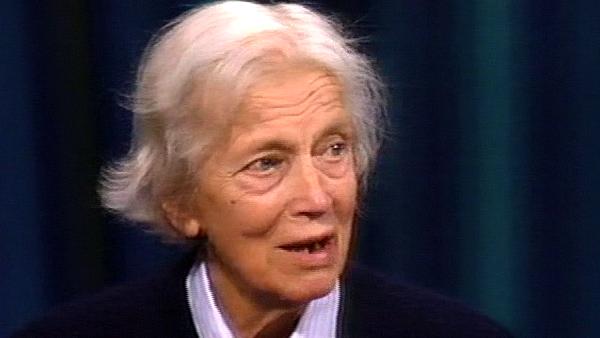NEXT STORY

My molecular model of penicillin
RELATED STORIES

NEXT STORY

My molecular model of penicillin
RELATED STORIES



|
Views | Duration | |
|---|---|---|---|
| 21. Working on cholesterol | 133 | 04:41 | |
| 22. Determining the chemical structure of penicillin | 160 | 06:39 | |
| 23. Work on penicillin | 101 | 03:34 | |
| 24. Crystallising penicillin | 85 | 04:25 | |
| 25. Photographing potassium, rubidium and sodium salts | 56 | 04:26 | |
| 26. Mapping the molecular structure of penicillin | 101 | 06:38 | |
| 27. Correlating the work on penicillin | 59 | 02:18 | |
| 28. Computing solutions for the structure of penicillin | 73 | 04:29 | |
| 29. My molecular model of penicillin | 94 | 03:27 | |
| 30. Visiting America | 109 | 02:12 |


One of the important stages in penicillin, which was during that year, took place during the X-ray analysis group meeting. When we decided to let Charles Bunn work on the sodium salt with us, and brought him into the collaboration. But we also were very anxious to arrange for better computing, particularly of the three-dimensional data, because we thought from a three-dimensional Patterson we might be able to get the structure straight away. And Charles... this somewhat odd character, Comrie, who had a computing firm, came through, and he discussed what we needed, because he said, of course, if we had suggested we only needed to calculate certain lines in the density to get what we knew, but he said, if you had the whole three-dimensional map, it would, of course, be much easier to calculate that. So I said, 'Well, we'd much rather have the whole three-dimensional map'. So then they got £1000 from the MRC [Medical Research Council], which they always thought was much too expensive, to get the punch cards made to enable the three-dimensional series to be calculated.
[Q] Now, when was that, Dorothy?
That was now getting on, when the X-ray analysis group was somewhere about April or thereabouts.
[Q] In '40...?
'45
[Q] '45. Right.
Yes. So Comrie went ahead with his organisation making the punch cards necessary. So we thought that if we finish the structure by ordinary criteria, I mean, put in enough hours and the rest of it, by May 1945 when we had the three projections. And Charles, of course, separately refined the sodium salts, so he had comparable...
[Q] Detail?
... details agreeing with ours. Well, then we didn't, we really felt we knew the structure before the three-dimensional cards came into our hands at all, but it seemed a pity not to use them, so we thought the obvious thing was to calculate the three-dimensional electron density, and it would enable us to refine the structure a little, and also check it. So, if we wanted to, we did this by having two calculations carried out, and that's what I think you're remembering. If we had one calculation we believed in, in which the...
[Q] All the atoms were put in?
... all the atoms were put in, as we thought they were, and then a second calculation, in which the beta-lactam atoms were moved into positions more corresponding to the oxyacetylene ring. And from the results there was no doubt at all that it was the thiazolidine and beta-lactam ring. But we generally had the molecules, the structure, from the moment we had the three projections. But, on the other hand, the setting up of the three-dimensional model on glass plates, is also historic. Because, although people don't now always make these models of their simple molecules, they make them of their complicated ones.
British pioneer of X-ray crystallography, Dorothy Hodgkin (1910-1994), is best known for her ground-breaking discovery of the structures of penicillin, insulin and vitamin B12. At age 18, she started studying chemistry at Somerville College, Oxford, then one of the University of Oxford colleges for women only. She also studied at the University of Cambridge under John Desmond Bernal, where she became aware of the potential of X-ray crystallography to determine the structure of proteins. Together with Sydney Brenner, Jack Dunitz, Leslie Orgel, and Beryl Oughton, she was one of the first people in April 1953 to see the model of the structure of DNA, constructed by Francis Crick and James Watson. She was awarded the 1964 Nobel Prize in Chemistry and is also known for her peace work with organisations such as Science for Peace and the Medical Aid Committee for Vietnam. All recorded material copyright of The Biochemical Society.
Title: Computing solutions for the structure of penicillin
Listeners: Guy Dodson
Guy Dodson studied chemistry and physical science at the University of New Zealand, followed by a PhD on the crystallographic study of an alkaloid. In 1961, he came to Oxford to work on the crystal structure of insulin. In the mid 1970s Guy and his wife moved to York University to establish a laboratory. In addition to insulin studies the laboratory has investigated many complex molecules of medical significance, including haemoglobin, myoglobin, HIV related proteins, proteases and proteins involved in managing nucleic acids in cells. In 1993, he went to the NIMR in London to establish a crystallographic group in an environment that spanned molecular, physiological and disease-related disciplines. Here his research began on some cell signalling proteins. His interests on medically relevant proteins included prions, malarial and TB proteins, and some clinically relevant thrombin inhibitors. Guy Dodson retired in 2004 but is still finding much to do in York and the NIMR.
Tags: Charles Bunn
Duration: 4 minutes, 29 seconds
Date story recorded: 1990
Date story went live: 02 October 2009